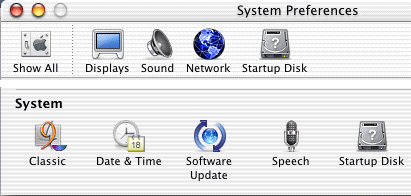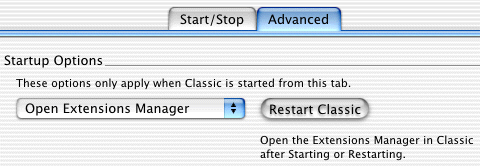If you've been using Macs for some time, odds are you've got lots of
files in your classic System Folder that don't work or aren't necessary
when using Classic mode in Mac OS X. Here's how to deal with that
- and get Classic to boot a bit faster at the same time.
Booting in OS 9.x, open the Extensions Manager control panel and
create a copy of your current configuration. Name it something like
"Mac OS X" as a reminder that you want to use this set of control
panels, extensions, and startup items when running Classic mode on
X.
Go through the list two or three times. For instance, if you have
iTunes under X, you probably won't be needing it in classic mode, so
you could disable all the extensions related to iTunes. The same goes
for unnecessary drivers and bits of software that won't run in Classic
mode. For instance, I've never used IR on my TiBook, so there's no
point loading it in Classic.
Go through the list two or three times - once sorted by name, once
sorted by
When you're done, you might want to go back to your regular OS 9.x
setup and turn off some of the drivers, extensions, etc. that you just
know you'll never use. Go through the list a couple times - there's a
lot there.
When you're ready to switch to X, select your OS X set in the
extensions manager, select OS X in the startup disk control panel,
and restart your computer. You'll be running Classic with a trimmer set
of software, so Classic will load a bit faster.
Oops, I Forgot to Switch
When running the classic Mac OS all by itself, you can choose a
software set from the Extensions Manager by holding the space bar at
startup. That doesn't work in Classic mode under OS X; X has a
different way of doing things.
Open your System Preferences and click on the Classic icon. It
should be in the lower left corner, as illustrated below.

When the Classic panel opens, click on the Advanced tab to view your
startup options. Here you can tell OS X to always open the
extensions manager when loading the Classic environment - sort of.

Unfortunately, as least through OS X v10.1.2, this setting is only
effective when you launch the Classic environment from the Classic
control panel. If you have Classic set to launch automatically, it will
do so using whatever set of extensions and control panels was active
the last time you used OS 9.x.
It would be nice if Apple or some independent programmer could
change this behavior to either force the Classic environment to always
use a preselected set of extensions or to open the Extensions Manager
at every Classic launch so the user can select the appropriate set.
On the flip side, it would be nice if a complementary extension
running under OS 9.x could automatically restore your most commonly
used set of extensions and control panels.





